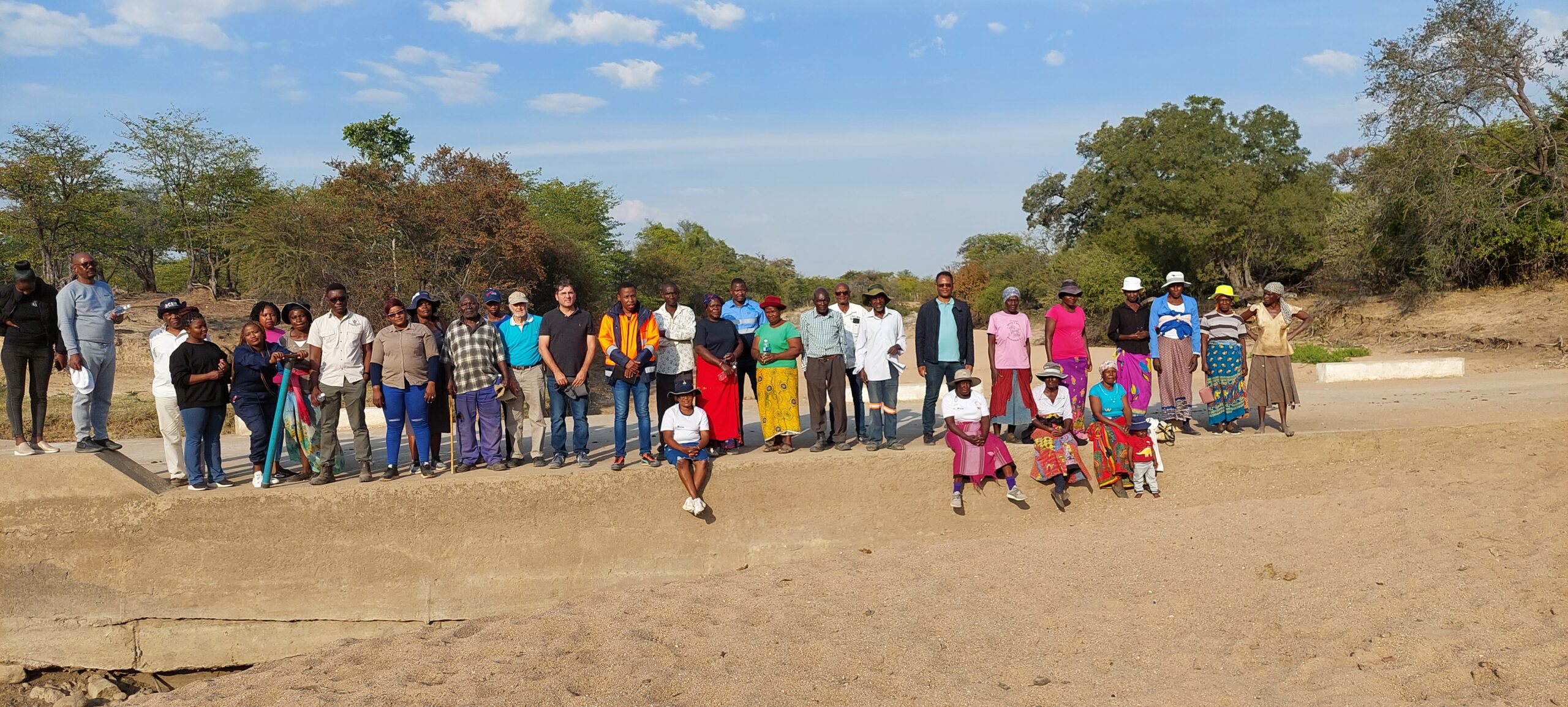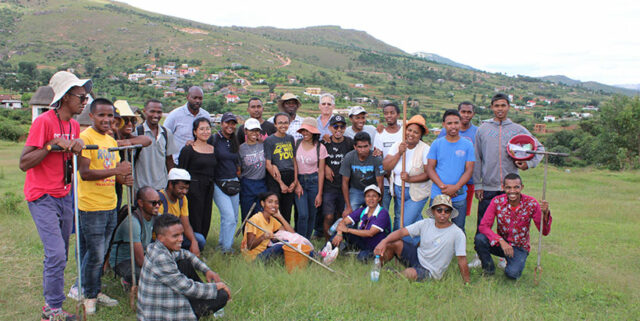
Meet NEXUS Gains’ partners in the Shashe sub-basin
The Shashe River originates in Botswana and forms part of the country’s long border with Zimbabwe, yet for much of the year, few would recognize this landmark as a river. Highly ephemeral, the Shashe is more commonly a dry, sandy channel. On the occasions that the rain replenishes it, the Shashe flows into the Limpopo River.
In this arid landscape, efficient, well-designed water storage is crucial to ensure food and water security, secure livelihoods, and build climate resilience. The CGIAR initiative on NEXUS Gains is working in the Shashe sub-basin to bring together stakeholders across sectors, from both banks of the river, to encourage collaboration, knowledge-sharing, and innovation.
Experts in integrated water storage
Dabane Trust works with rural communities in the arid and semi-arid regions of southern and western Zimbabwe. This non-profit organization has extensive experience of supporting water and food security through the construction of sand dams in ephemeral sand rivers, including the Shashe. These integrated water storage solutions are particularly effective at capturing and storing water, even during periods of low rainfall. Using a highly efficient Rowa pump, communities pump clean water from the sand during the dry season for domestic use, irrigation, livestock, and other livelihood activities.
Although sand dams have many benefits, they are frequently absent from infrastructure planning, as there is little awareness of this type of storage. Through its collaboration with NEXUS Gains, Dabane Trust is hoping to change this. The NEXUS Gains initiative actively fosters collaboration between the public, private, and non-profit sectors, as well as between actors from both Botswana and Zimbabwe, which is essential for effective management and planning in this transboundary sub-basin. This collaboration also facilitates the sharing of information on the construction and use of sand dams, as well as their many benefits.
A space to share knowledge and experience
One such opportunity for cross-sectoral knowledge sharing was NEXUS Gains’ integrated water storage workshop, held in Bulawayo, Zimbabwe, in June 2023. During the three-day event, participants visited a sand dam, and had the opportunity to speak with community members about how it had impacted their daily lives. This was the first time that Dabane Trust had worked with partners in Botswana, and Nobubelo Ngwenya, the trust’s Water and Geographic Information System (GIS) Officer, reflected on the event:
“NEXUS Gains is bridging the gap between sectors: in the workshop we had stakeholders from both countries, from the ministries, and from the catchment councils. These groups were not including sand dams in their planning at national level because they were not aware of them and how much they have benefited communities. Now that they’ve seen how it works, they’ve gained an understanding, and if we want to start a new dam construction project, we’re hoping that the catchment councils will be more involved from start to finish. This is a positive thing that NEXUS Gains has brought.”
Transboundary learning
One of the participants who was introduced to sand dams through this workshop was Maduo Dingalo, a master’s student in hydrogeology at the University of Botswana. Maduo described the event as “eye-opening, because sand dams are not common in Botswana.”
Maduo’s research focuses on transboundary aquifers. With support from the International Water Management Institute (IWMI) and NEXUS Gains, he has received funding to carry out field work, enabling him to create a geophysical model of the aquifers in the Shashe sub-basin. One aim of this model is to indicate potential borehole sites to supply water to vulnerable communities. With his understanding of sand dams and new connection with Dabane Trust, Maduo is considering including these dams in his research paper as an acknowledgement of their effectiveness and suitability in this arid environment.
“Sand dams are one area which we might want to explore in future,” he explained. “If we approach relevant stakeholders and inform them of the sand dams, it may be something they can potentially look at. Nobubelo is very experienced in that aspect; I would like to keep in touch, so that when we approach stakeholders in Botswana, we have someone who can inform them of the benefits of this type of water storage.”
The importance of community buy-in
Dr Ebenizario Chonguiça is a specialist in fluvial geomorphology at the Limpopo Watercourse Commission (LIMCOM). LIMCOM was established by the four states in the Limpopo Basin: Botswana, Mozambique, South Africa, and Zimbabwe, and works across these countries to better conserve and manage the Limpopo River. In the Shashe sub-basin, the commission is developing sustainable land management strategies to assist in reducing soil erosion and reservoir sedimentation. Dabane Trust is partnering with LIMCOM on this project in Zimbabwe, and the site visit during the NEXUS Gains workshop introduced Ebenizario to another aspect of Dabane Trust’s work.
What really stood out to him was how the community had taken real ownership of the sand dam. “You have that level of involvement because the sand dam is tackling very important needs for the communities; I’ve never seen that level of involvement before, especially by women. There was a lot of female representation in that community driving the process. When we talk about dams, there is the perception that this is a male business. But the women are very well represented; they know how to do the maintenance of the pumps and protect them from vandalism. The community is very much involved in assuming that investment as their own; it’s not like an external arm is coming in and doing the work for them. So even if the project moves away, there is high potential for the continuity and sustainability of the investment.”
A whole-systems approach to water
All the participants are emphatic about the importance of the water–energy–food–ecosystem nexus in their work. Dabane Trust has considered the use of solar water pumps, for example, to reduce dependence on fossil fuels, and has put guidelines in place which ensure environmental threats, such as siltation, are dealt with before sand dam construction work begins. It also facilitates water, sanitation, and hygiene training to ensure that once water is extracted from the sand dams, it is stored in a clean, safe way on the homesteads.
Ebenizario has appreciated the opportunity to work through NEXUS Gains, and the opportunities that the systems approach can bring for innovation. “Water scarcity is not fiction, it is real, and we all know how critical access to water is for livelihood purposes. The intervention by NEXUS Gains means that there are innovative ideas, innovative approaches being put on the table. This is contributing to minimize the challenges of water scarcity and creating another avenue for responding to the challenges of living in arid conditions.”
Maduo views the nexus approach as integral to his work as a scientist and researcher. “Water is life,” he says. “For everything to function, people need water. As geoscientists, as hydrogeologists, it is our job to ensure that – even in the most remote areas – people get sufficient and clean water. NEXUS Gains is all about ensuring that people can get water equitably and sustainably for the future generation without overexploiting the resource.”
Header image: Participants at NEXUS Gains’ integrated water storage workshop, held in Bulawayo, Zimbabwe, in June 2023. Photo by Girma Ebrahim/IWMI.



